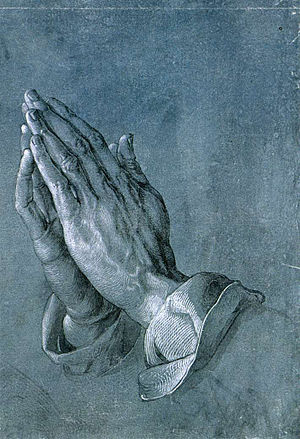| English: Mysore painting depicting Hindu Goddess Lakshmi (Photo credit: Wikipedi |
When Christians, Muslims, or Jews first
encounter Hinduism they are likely to be struck by (and misunderstand) the
profusion of gods and goddesses, vividly represented in paintings, sculpture,
and other forms. Also, words used in
English sometimes are not precisely chosen or accurate representations of
reality. For example, there is not
"worship" of nature in various forms, cows, etc. Life and living things are venerated or
honored or revered as representations and expressions of the Divine. They are not "worshiped" in any sense
different from how pictures of saints, the cross, the Star of David, pictures of
Yashua, the Christ, and so forth are "worshiped." This is a great misinterpretation and
misunderstanding, perhaps due to limitations of language and different usages
of words and phrases.
| Maestà (Madonna with Angels and Saints) (Photo credit: Wikipedia) |
First impressions can sometimes be mistaken,
for Hindus regard gods and goddesses as manifestations of the One Supreme God. Hinduism is in fact monotheistic. In the Vedantic schools of Hinduism, God is
the unchanging, infinite, immanent, and transcendent reality that is the Divine
Ground of all Being and basis of Creation.
This Supreme Cosmic Spirit is eternal, genderless, omnipotent, and
omniscient. It can be described as
infinite Truth, infinite Consciousness, infinite Love, and infinite Bliss. There is a remarkable similarity between this
set of attributes and those ascribed by Christians, Muslims, and Jews to the
one God of classical monotheism.
Historian
Arnold Toynbee once wrote, "We do know
that there are more approaches to
truth than one, and more means of "salvation" than one." This is a hard saying for adherents of
Judaism, Christianity, and Islam, but it is a truism for Hindus. The spirit of mutual good-will, esteem, and
veritable love ... is the traditional spirit of the faith of the Indian family.
This is one of India’s gifts to the
world.
Joseph Campbell put it this way, "The first principle of Indian thought,
therefore, is that the ultimate reality is beyond description. It is something that can be experienced only
by bringing the mind to a stop; and once known, it cannot be described to
anyone in terms of the forms of this world. The truth, the ultimate truth, that is to say,
is transcendent. It goes past,
transcends, all speech, all images, anything that can possibly be said. But, as we have just seen, it is not only
transcendent, it is also immanent, within all things. Everything in the world, therefore, is to be
regarded as its manifestation."
Just as there are "representatives"
of almost every faith, which may tend toward the "my way only" or
judgmental or dogmatic lines of thinking, there are these various sorts of
thinking, writing, speaking, and behaving among those claiming to represent
Hinduism. However, no true Hindu will
ever "judge" or "disown" someone of another faith, whether
from his own family or village or otherwise!
| Amarillo Tx - Dynamite Museum - Love World Round (Photo credit: Wikipedia) |
At the core, all are same: based in Selfless Loving Service. Within Christ followers, there is a renewed
appreciation for the immanence of God and a recovery of the mystical sense of
God's presence within the world of time and space. Further, the contemplative practices identified
with Hinduism, Buddhism, etc. are essentially the same as those in "Christ-ianity,"
Judaism, and other faiths, bringing the spiritualities of various faiths closer
together. All, ALL, are our
Brothers. May we Revere and Love One
Another . . . At the core, at the Heart,
we are All the Same . . .
by Vinita
Channahsorah, a first year student at TNS, has had a life-long calling in
interfaith ministries in various forms, roles, and settings. Her parents brought her up reading excerpts
from scriptures of many different faiths, and there were often persons from all
faiths, groups, cultures, and backgrounds in the house. She has always lived in a universe where all
faiths are the same at the core, with Agape' Love as the basis of all along
with Selfless Loving Service—God Almighty can manifest and work in and through
Mankind in an infinite number of ways and forms. Dr. Channahsorah recently graduated the
Shalem Institute's two-year program, "Leading Contemplative Prayer Groups
and Retreats: Transforming Community." In addition, she guides (or facilitates)
prayer in many faiths in various forms, such as readings, silent contemplation,
walking-prayers, and guitar & hymn compositions.





